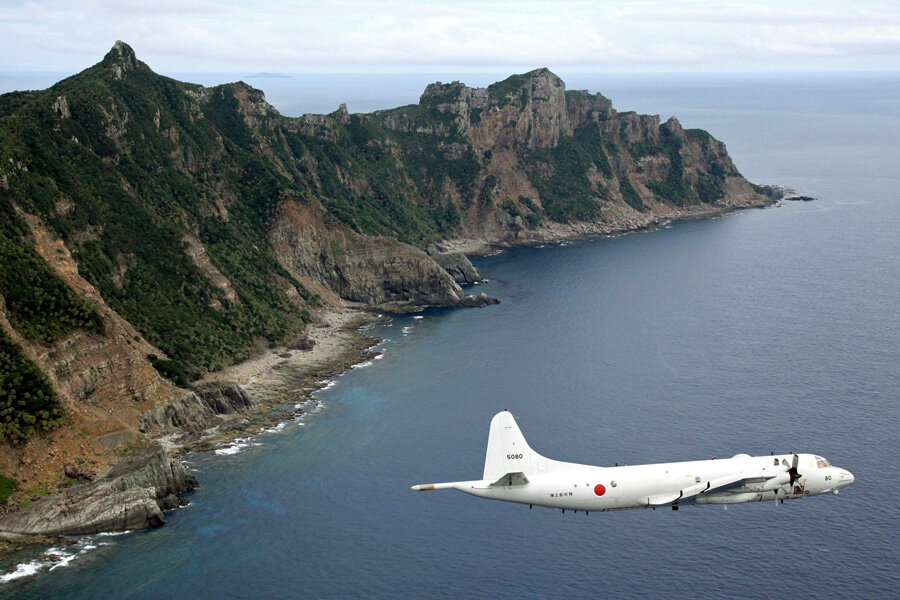Is China's air defense zone a game changer?
Loading...
| Beijing
China has ruffled a lot of international feathers with its weekend declaration of an “air defense identification zone” over airspace already claimed by Japan. Now the question is whether Beijing will aggressively enforce its self-declared rights – and whether they are capable of doing so.
The United States, Japan, South Korea and Taiwan have all rejected, condemned or regretted Beijing’s announcement Saturday that all foreign aircraft must file flight plans before entering its newly declared zone, which includes Japanese-administered islands that China also claims.
Japan has said it will ignore the Chinese demand, which Japanese Foreign Minister Fumio Kishida called a “one sided action” that “cannot be allowed.” That heightened fears of a military clash in the contested area.
“Irrational actions in the ADIZ [air defense identification zone] could lead to conflict,” says Wang Jinling, a former Chinese military officer who now heads San Lue, an independent think tank on security affairs in Beijing. “Real clashes are possible.”
But a clash isn't likely, he adds. “China’s intention is not to show its military strength or to spark a conflict, but to underline its sovereignty” over the disputed islands, known as the Diaoyu in China and the Senkaku in Japan.
That is a view shared by a senior Japanese military analyst, who asked not to be identified because of the sensitivity of the issue. “Both sides want to avoid an incident around the Senkakus,” he says. “Both militaries have been very, very careful about not going into each others’ air or sea space” since the dispute broke out in September last year, deploying civilian proxies such as Coast Guard vessels instead, he points out.
But with both sides claiming the right to monitor aircraft in an overlapping zone, and to scramble fighters to deal with unidentified craft, accidents are more likely. US Secretary of Defense Chuck Hagel warned Saturday that China’s declaration of an ADIZ “increases the risk of misunderstanding and miscalculations.”
Chinese radar capabilities questioned
Such risks may be heightened, Japanese and other military experts say, because the Chinese military does not appear to have sufficiently sophisticated radar capability to track fighter planes flying at low altitudes over the disputed islands, which are more than 200 miles from the Chinese coast.
Beijing explained its declaration of an air defense identification zone, similar to zones declared by the US, Japan, and a number of other states, as designed “to defend national sovereignty and territorial and air security,” according to a statement on the Defense Ministry website.
If foreign aircraft in the zone refuse to identify themselves or to follow Chinese instructions, “China’s armed forces will adopt defensive emergency measures to respond,” Beijing’s statement said.
“This is a reminder to Japan that [China is] serious and prepared to hold to their position indefinitely until they get a concession,” says Denny Roy, an analyst at the East-West Center in Honolulu. “They want Japan to acknowledge there is a territorial dispute” and are taking steps towards de facto co-administering the islands.
The Japanese government, however, is showing no signs of being prepared to accept the existence of a dispute. Officials in Tokyo increasingly view Chinese pressure as a test of their determination; should they cede on the Senkakus, they fear, China will then press on other issues.
Nor will Japanese pilots obey Chinese demands for identification, the Japanese military analyst says. “That is unacceptable. It would sound as if we admit their claim” to the disputed territory, he points out.
China won no international sympathy for its move. US Secretary of State John Kerry said Washington was “deeply concerned” by what he called “an attempt to change the status quo in the East China Sea.” South Korea said the Chinese announcement was “regrettable,” not least because China’s new ADIZ overlaps with Seoul’s zone, and Taiwan, which also claims the Diaoyu islands, urged Beijing not to use military means to resolve its territorial dispute.
Island purchase stirs dispute
Tensions between China and Japan, the second and third largest economies in the world, have worsened since the Japanese government bought three of the disputed islands in 2012 from their private Japanese owner, saying it wanted to keep them out of the hands of a nationalist firebrand who could them to provoke Beijing.
China, however, saw the move as a violation of a longstanding informal agreement to leave the territorial dispute in abeyance pending a possible agreement to jointly exploit any resources, such as oil and gas, which may be discovered in the islands’ vicinity.
Beijing formalized its claim to the islands and surrounding ocean last year, publishing territorial baselines, and has since dispatched Coast Guard ships and other civilian vessels into or near Japanese waters on an almost daily basis. Japanese F-15 jets have scrambled about 300 times since the crisis erupted 14 months ago to deter potential intruders.
Only very rarely, however, has China deployed military vessels or aircraft in a threatening fashion. If Beijing wanted to ratchet up the pressure, suggests Dr. Roy, it could step up the frequency of its air and sea patrols around the islands, “or swap in navy ships for the maritime patrol ships they have been using.”
That, he says, “would mark a big escalation” in the dispute.
With tensions between the two neighbors rising, says Mr. Wang, “now is not the moment for their militaries to compete in strength, but for their leaders to compete in wisdom.”






